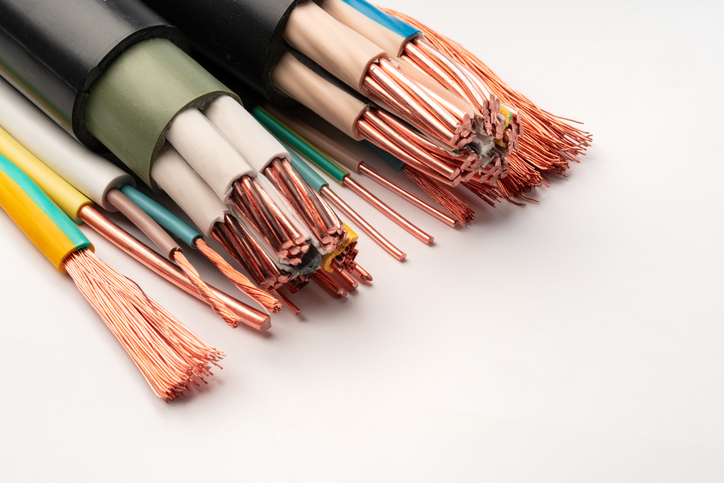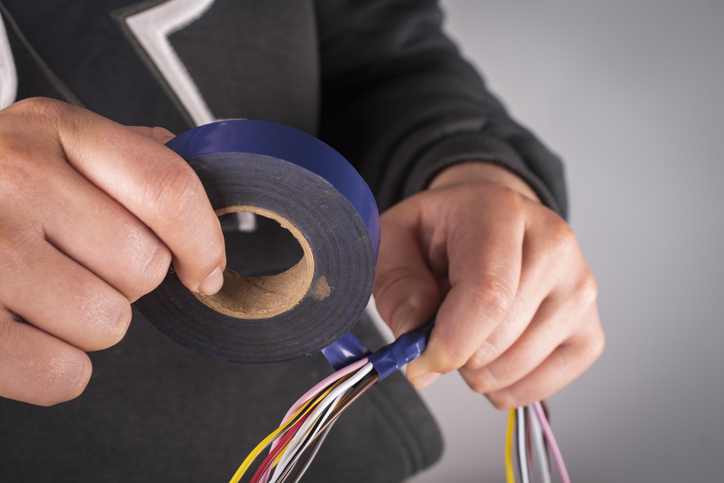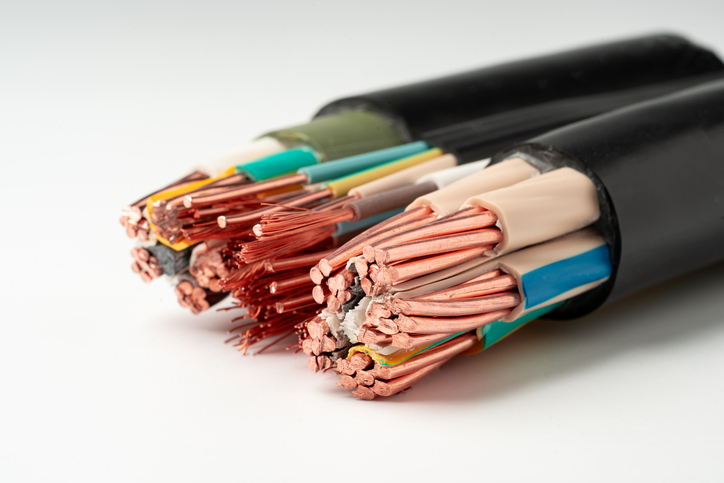Popular Jacket Types
Jackets cover and protect the enclosed wires or core against damage, chemical attack, fire and other harmful elements which may be present in the operating envrionment.
 Selection Criteria:
Selection Criteria:
- Thermoplastic of Thermoset
- Offgassing
- Abrasion
- Chemical Resistant
- Oil Resistant
- Cold Temperatures
- Ozone
- Heat Resistant
Thermoplastic vs. Thermosetting
THERMOPLASTIC: A material which will soften, flow, or distort when subjected to sufficient heat and pressure. These compounds are heated and extruded over conductor. Likewise, the insulation on the finished product can be re-melted or soften if exposed to heat.
- Easy to manufacture
- Normally less expensive
- No cure required
- Will melt when subjected to heat
- Can be extruded in very thin walls
THERMOSETTING: A material which will not soften, flow, or distort when subjected to heat and pressure. Once extruded over conductor, these compounds will not re-melt, however, they can be burnt or deteriorate due to heat.
- Will harden and age when overheated
- Forgiving when exposed to overloads
- Better low temperature properties
- Higher temperature potential
- Usually more expensive
- Requires a cure process when extruded
- Not extruded smaller than 22 AWG in CV processes. Irradiated products can be extruded in smaller sizes.
Thermoplastic Compounds
POLYVINYL CHLORIDE PVC, sometimes referred to as vinyl or polyvinyl chloride, consists of three types of vinyl compounds - standard, semi-rigid and irradiated. Depending upon the formulation the rated temperature may vary from -55 C to 105 C. Typical dielectric constant values can vary from 2.7 to 6.5
STANDARD PVC, rated for 1000 volts or less, is used for hook-up, computer and control wires. Different compounds are used for 60C, 80C, 90C and 105C service along with commercial and military applications.
SEMI-RIGID PVC (SRPVC) is much tougher than standard vinyl. It has greater resistance to abrasion and cut-through and offers more stable electrical properties.
IRRADIATED PVC has improved resistance to abrasion, cut-through, soldering and solvents. Irradiation changes the vinyl from a thermoplastic to a thermosetting material.
POLYETHYLENE (PE) is a very good insulation as it offers a low dielectric constant, a stable dielectric constant over all frequencies and a very high insulation resistance. In terms of flexibility, polyethylene can range from stiff to very hard depending on molecular weight and density. Low density is the most flexible, while high density and high molecular weight formulations are very hard. Moisture resistance is excellent, however, both types are flammable. Brown and Black formulations have excellent weather resistance. The dielectric constant is 2.3 for solid insulation and 1.5 for cellular (foamed) designs.
RULAN is a flame retardant polyethylene which contains additives to inhibit the rate of burning. These additives have only a slight effect on physical or electrical properties of the insulation.
PROPYLENE (Solid and Cellular) is similar in electrical properties to polyethylene. This material is primarily used as an insulation. Typically, it is harder than polyethylene, making it suitable for thin wall insulations. UL maximum temperature ratings may be 60C or 105C. The dielectric constant is 2.59 for solid and 1.55 for cellular (foamed) designs.
KYNAR has great mechanical strength, superior resistance to abrasion and cut-through and substantially reduced cold-flow which makes it an excellent back plane wire insulation. Kynar is self-extinguishing, radiant resistant and rated at 135C.
TEFZEL (ETFE) is rated at 150C, has very good electrical properties, chemical inertness, high flex life and exceptional impact strength. Tefzel can withstand an unusual amount of physical abuse and is self-extinguishing. Tefzel is a registered trademark of DuPont Corporation.
HALAR (ECTFE) has a specific gravity of 1.68, the lowest of any fluorocarbon. Its dielectric constant and dissipation factor at 1 Mhz are 2.6 and 0.013 respectively. Halar chars, but does not melt or burn when exposed to direct flame and immediately extinguishes on flame removal. Its other electrical, mechanical, thermal and chemical properties are almost identical with Tefzel's. Its temperature rating is -70C to 150C. Halar is a registered trademark of Ausimont Corporation.
TEFLON (FEP) is extrudable in a manner similar to PVC and polyethylene, allowing for long wire and cable lengths. FEP has excellent electrical characteristics, chemical inertness and a service temperature of 200C. Teflon is a registered trademark of DuPont Corporation.
TEFLON (TFE) is extrudable in a hydraulic ram type process. Lengths are limited due to the amount of material in the ram, thickness of the insulation, and preform size. TFE must be extruded over a silver or nickel coated wire, with ratings at 260C and 200C respectively. Teflon is a registered trademark of DuPont Corporation.
PFA is the latest addition to DuPont's Teflon resins. Like the others it has outstanding electrical properties, high operating temperature (250 C), resistance to virtually all chemicals and flame resistance. PFA is a registered trademark of DuPont Corporation.
THERMOPLASTIC RUBBER (TPR) has properties similar to those of vulcanized (thermosetting) rubbers. The advantage is that processed like thermoplastics, it is extruded over the conductor. Like many conventional rubber materials, TPR is highly resistant to oils, chemicals, ozone and other environmental factors. It has low water absorption and excellent electrical properties, and is very flexible with good abrasion resistance.
Thermoset Compounds
CHLOROSULFONATED POLYETHYLENE (CSPE), better known as Hypalon, is sometimes used as a 105C rated motor lead wire insulation, but most often as a jacketing compound. Hypalon has excellent tear and impact strength, excellent abrasion, ozone, oil, and chemical resistance and good weathering properties. This material also has low moisture absorption, excellent resistance to flame and heat, and good dielectric properties. Hypalon is a registered trademark of DuPont Corporation.
SILICONE is a soft insulation which possesses a typical temperature range from -80C to 250C. It has excellent electrical properties plus ozone resistance, low moisture absorption, weather resistance and radiation resistance. Silicone typically has low mechanical strength and poor scuff resistance. While silicone rubber burns slowly, it forms a non-conductive ash which, in some cases, can maintain the integrity of the electrical circuit.
ETHYLENE PROPYLENE RUBBER (EPR) is a chemically cross-linked, thermosetting high temperature rubber insulation. It has excellent electrical properties combined with outstanding thermal stability and flexibility. EPR's resistance to compression, cutting, impact, tearing and abrasion is good and is not attacked by acids, alkalis and many organic solvents. It is also highly moisture resistant. EPR has temperature ratings up to 150C.
CROSS-LINKED POLYETHYLENE(XLP) is a material which has greater resistance to environmental stress cracking, cut-through, ozone, solvents and soldering than either low or high density polyethylene. Sometimes designated as XLPE. Can be cross-linked either chemically or irradiated.
SEMI-BUTYL RUBBER (SBR) is flexible and offers good heat and moisture resistance at an economical cost. It must be jacketed for mechanical and chemical protection. SBR is suitable for 75C max temperature ratings.
Note: ratings are based on average performance of general purpose compounds. Any given property can usually be improved by the use of selective compounding
Typical Properties of Common Jacketing Materials
|
|
PVC |
PE |
NYLON |
FEP |
TFE |
NEOPRENE |
|
Specific Gravity |
1.37 |
0.92 |
1.09 |
2.20 |
2.15 |
1.52 |
|
Tensile Strength (PSI X 1000) |
1.5-3.8 |
1.4-2.4 |
8.8-11.9 |
2.3-3.1 |
2.0-6.0 |
2.5-4.0 |
|
Elongation, % |
200-375 |
350-550 |
150-380 |
200-330 |
200-500 |
300-500 |
|
Service Temperature Range, C |
-55 TO +105 |
-20 TO +75 |
-55 TO +105 |
-70 TO +200 |
-70 TO +260 |
-30 TO +90 |
|
Ozone Resistance |
Excellent |
Good |
Good |
Excellent |
Excellent |
Excellent |
|
Weatherability |
Good-Fair |
Excellent-Good |
Fair-Poor |
Excellent |
Excellent |
Good |
|
Flame Resistance |
Self-Extinguishing |
Supports Flame |
Self-Extinguishing |
Non-Flammable |
Non-Flammable |
Self-Extinguishing |
|
Abrasion Resistance |
Fair-Good |
Good |
Excellent |
Excellent |
Excellent |
Excellent |
|
Flexibility |
Good |
Poor-Good |
Good |
Good-Fair |
Good |
Excellent |
|
Acid Resistance |
Fair-Good |
Excellent |
Excellent |
Poor |
Excellent |
Good |
|
Hydraulic Fluid Resistance |
Fair |
Good-Fair |
Fair-Poor |
Good-Fair |
Excellent |
Good |
|
Organic Solvent Resistance |
Good |
Fair-Poor |
Poor |
Good-Fair |
Excellent |
Good |
|
Resistance to Tearing |
Good |
Good |
Good |
Excellent |
Good |
Good |
Related Resources

Jacket Selection
Cable jackets, also known as sheaths, serve a crucial role in safeguarding the internal components of a cable. Learn More
Tape Types
Tape insulations play a crucial role in providing electrical insulation , particularly in scenarios where other materials might fall short.Learn More
Color Codes
Many different wire identification rely on color codes and not all color codes are the same.Learn More


